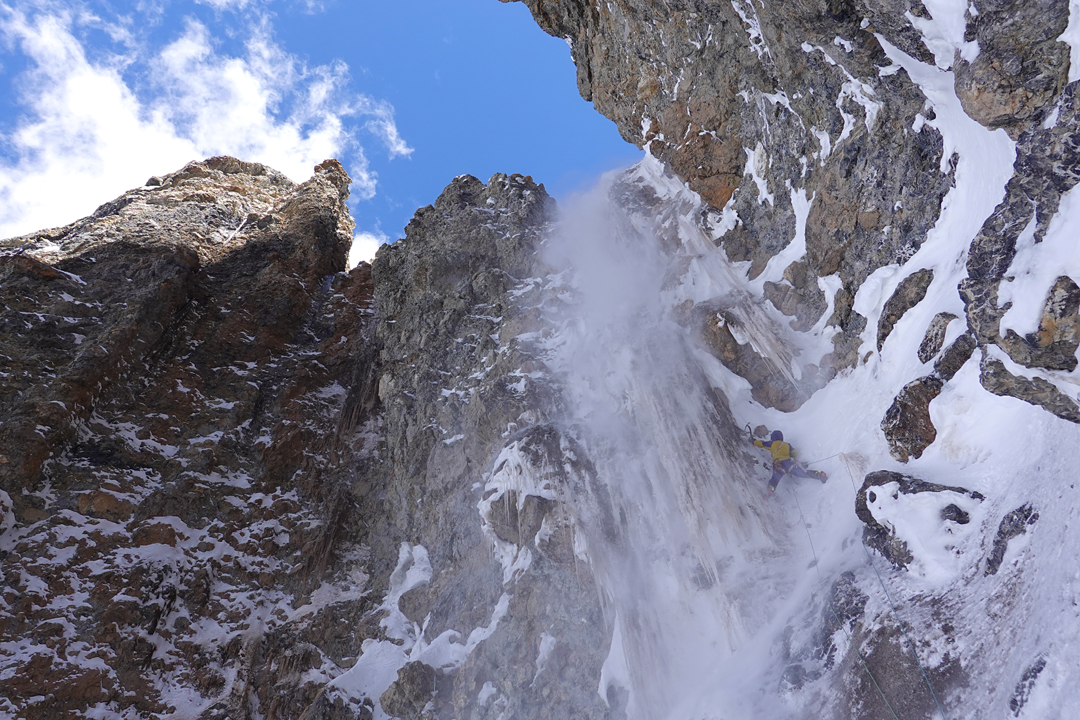Karun Koh, Northwest Face
Pakistan, Karakoram, Ghujerab Mountains, Karun Koh Subgroup

In the winter of 2021, Kazuya Hiraide and Takuya Mitoro planned to attempt Karun Koh (6,977m), but during a preliminary climb, the first ascent of neighboring Sami Sar (6,032m), Hiraide suffered frostbite and was evacuated by helicopter from base camp (AAJ 2022). Hiraide and I presumed it would be difficult for us to make an expedition in 2022, but Hiraide trained hard after his surgery in February, and toward the end of August we flew to Pakistan. I was excited by the prospect of climbing a beautiful line on a mountain that looked as cool and pyramidal as Karun Koh.
We arrived at Sost on September 3, and after collecting a few porters, continued up the Karakoram Highway to the start of the Unakin-i-Dur valley, which leads to the northwest face of Karun Koh. It took three days to reach base camp, where we said goodbye to our porters and guides. Due to a last-minute change in our departure date, we were unable to secure any staff to stay with us at base, so we began our self-catering expedition. Neither of us is an expert cook, so we planned to make the summit as quickly as possible and eat delicious food once we had regained civilization.
By the 10th we had completed a five-day reconnaissance and acclimatization to 6,000m. We were ready for a summit push, but just at that moment we were hit by the worst weather cycle since arriving in the country. It rained and snowed daily at base camp, with occasional sunshine. The next weather window arrived a week later, when we had exhausted our culinary repertoire and were beginning to run out of food.
On the 19th we moved up the Unakin Glacier and pitched our tent below the northwest face of Karun Koh at 5,200m. The next day we started in earnest; our schedule meant this would be our first and last chance. We climbed for five hours up 60° slopes to reach the middle section of the face, where it narrows to a tight gully. Here, the angle was much steeper than we had imagined, and the rock we had planned to climb was too fragile. Thin ice to the side looked more feasible, so we opted for that. Two hours and two pitches of 90° ice later, climbing through spindrift avalanches, we reached the exit.

After an hour of chopping and clearing at around 6,200m, we had created a tent site—not the most comfortable, but at least we could lie down. We felt better now that we were past the crux.
The sky was overcast on the 21st as we left the tent in place and climbed the upper face toward the summit. My calves and thighs were screaming due to the sustained movement on hard blue ice, and the altitude made it difficult to go any faster. Gradually, the weather worsened, we became surrounded by mist, and by the time we reached the summit ridge, which was not easy, there was a whiteout. At 2:50 p.m. the ridge divided and both branches began to descend. We knew we were at the summit. Sadly, there was no view, but we were relieved to know we could now go down.
We rappelled the summit ridge from snow stakes, then made 21 50m rappels from Abalakovs down the face. We had to use headlamps to find the tent, half buried by snow. The sleeping space was now even smaller than the previous night, but we were grateful to lie down.
On the 22nd we continued rappelling, reached the bottom of the face, and returned to base camp. The glacier felt long and tiring, but we were filled with a sense of fulfilment. We were satisfied that we had climbed Karun Koh in our own style, via a perfect line (1,800m, AI5). [The first ascent of Karun Koh was in 1984 by the west-southwest ridge.]
— Kenro Nakajima, supplied by Shingo Fukuda, Ishii Sports, Japan





